Yoga For Depression And Anxiety:
Jump To:
Chronic pain and depression frequently are comorbid. They are associated with decreased function, poor outcomes, and increased healthcare costs. The following is yoga for depression and anxiety. The International Association for the Study of Pain defines pain as “an unpleasant sensory and emotional experience associated with actual or potential tissue damage or described in terms of such damage”.
Nadi Shodhana pranayama and a 10-minute daily yoga for beginners can help get you on track. The Surya Namaskar or Sun Salutation is the core of yoga. The Surya Namaskar gives you the benefits of both Asanas and Pranayama. Check out how to do surya namaskar.
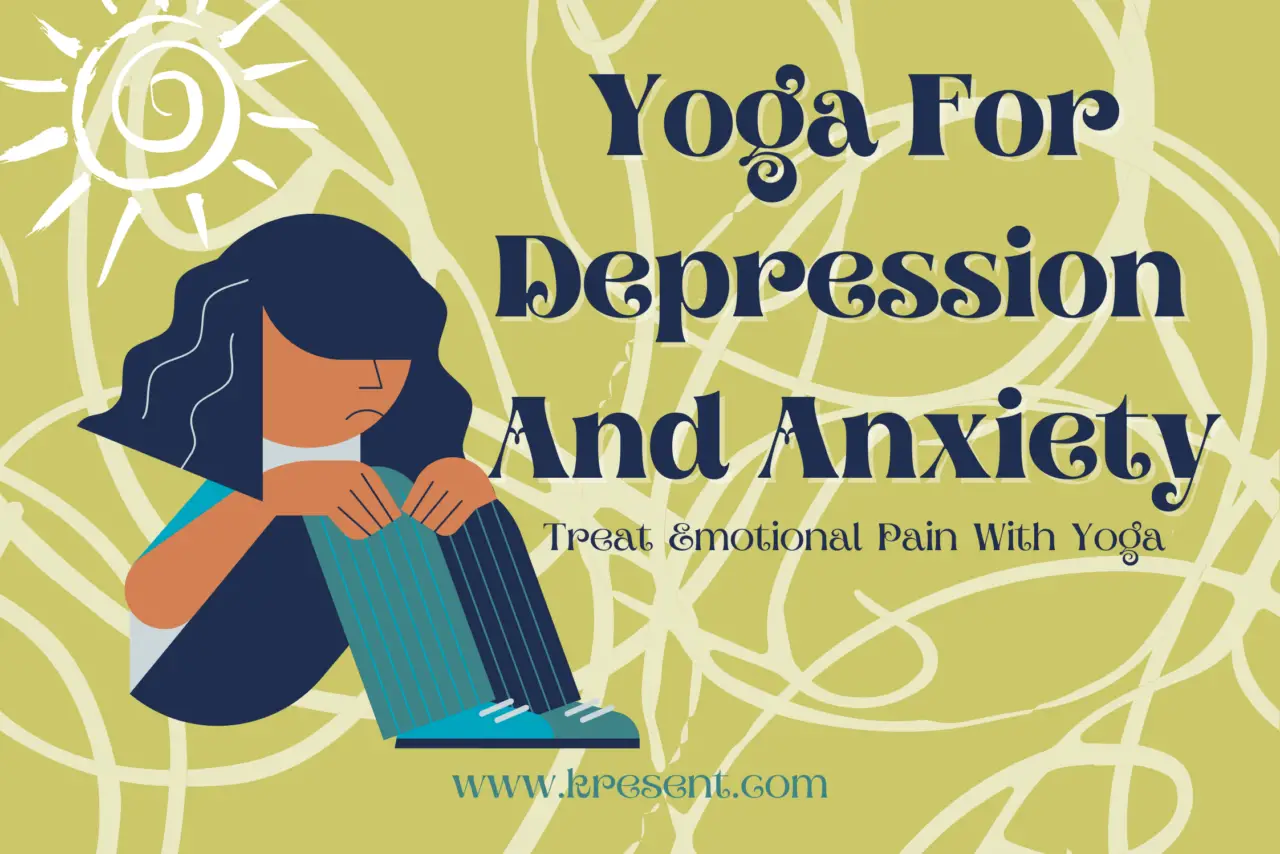
Depression Symptoms:
Two Types Of Pain In Depression:
Neuropathic pain is caused by a lesion or disease involving the nervous system. It may have signs of altered pain response (allodynia, hyperalgesia) and is treated with agents targeting the nervous system abnormality.
Nociceptive pain occurs as a consequence of actual or threatened damage to non-neural tissue. It reflects a normally functioning somatosensory nervous system and responds to general analgesics and anti-inflammatory drugs.
Neuroplastic change is one possible explanation for the altered pain perception, the persistence of pain beyond tissue healing, and resistance to commonly used analgesics that are frequently found in chronic pain.
Daily challenges of chronic pain:
- Decreased enjoyment of normal activities.
- Loss of function
- Role change
- Relationship difficulties
Uncertainty about ever being pain-free or the possibility of worsening pain is accompanied by the following:
- Anxiety
- Sadness
- Grief and anger
For some people, the burden of pain is challenging to manage and may lead to the emergence of a mental disorder. The presence of catastrophization with excessive rumination about the pain, magnification of distress, and excessive helplessness is associated with a weaker response to pain treatments and more significant disability.
Major depression is the most common mental illness associated with chronic pain. In patients with chronic pain, the prevalence of major depression is 30%-40%.
Yoga For Depression:
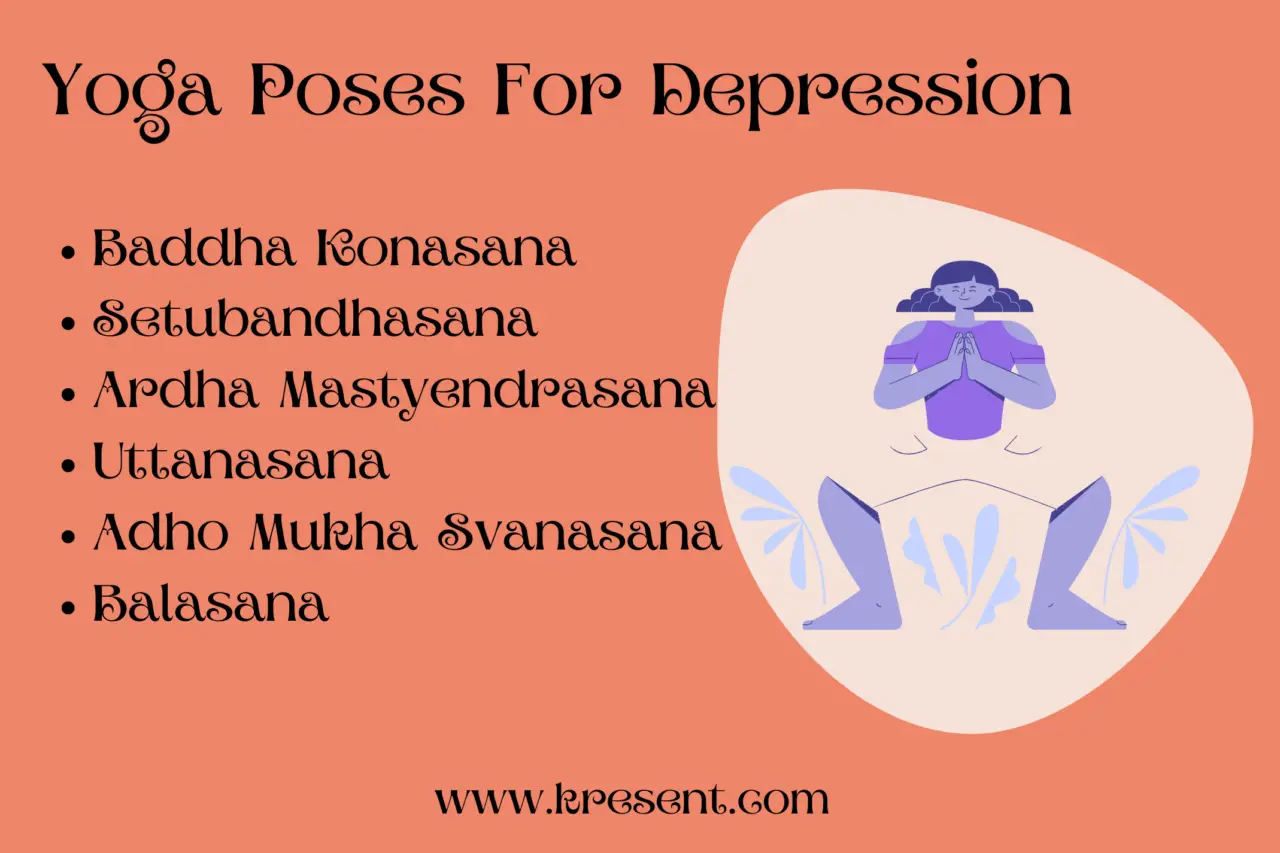
1. Baddha Konasana (Bound Angle Pose):
This is a classic pose in yoga for depression sequence as it benefits the entire body. Apart from being an excellent hip opener, it stimulates the abdominal organs, the ovaries, and kidneys. It stimulates the heart and improves circulation.
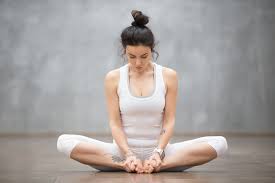
Baddha Konasana (Bound Angle Pose) Steps:
- Sit with your legs straight in front of you. Lift the hips a bit off the floor and place a cushion under them.
- Inhale; bend the legs towards the chest. Exhale; drop the right knee to the right and the left knee to the left and allow the souls to touch each other. Place the palms on the floor behind the hips and extend the spine by pressing on the palms.
- Hold this pose, breathing deeply for 10 breaths.
- Inhale; lift the palms and reach forward to hold the toes or the feet with both your hands.
- Exhale; bend the elbows onto the thighs and press them down towards the floor, feeling a stretch on the hips and the thighs. If the knees don’t touch the floor, do not force them as this is due to tight hips. Place a block or bolster under the knees to support them.
- Hold this pose for a few breaths; release.
2. Setubandhasana (Bridge Pose):
This pose will strengthen the legs and open the shoulders and stabilize them. It stretches the neck, improves blood circulation, and balances hormones. It also makes the body and mind strong.
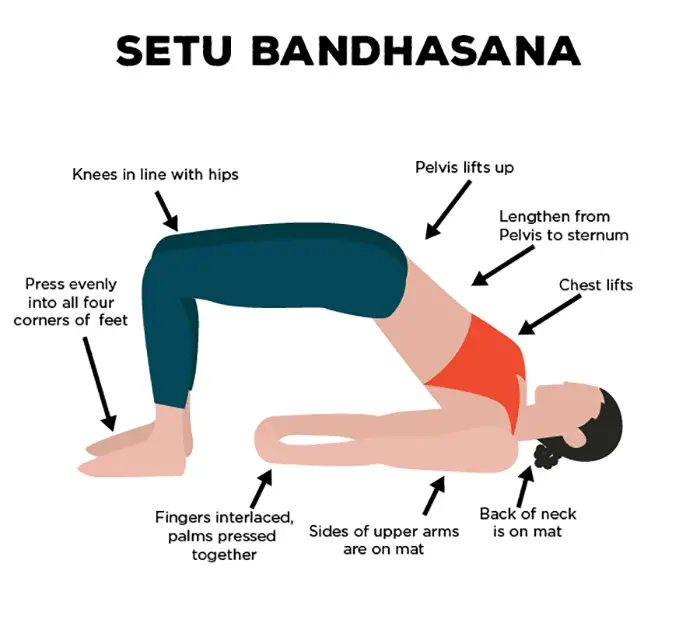
Setubandhasana Steps:
- Lie down on the floor with palms close to the body and the legs, hip distance apart.
- Bend the knees with the feet in line to the knees and chin down towards the chest.
- Inhale; press the feet on the floor and contract the inner thighs. Lift the hips off the floor and push the tail bone towards the floor.
- Exhale; keep the palms on the floor or slide the hands under the hips. Clasp the hands together to interlock the palms.
- Hold the pose breathing deeply in ujjayi breath for 30 to 50 seconds. Work engaging the thighs and lifting the chest higher off the floor, so that the chest touches the chin and the shoulders squeeze towards each other.
- Exhale; lower the chest, belly, and then the hips on the floor to release the pose. Straighten the legs and rest and focus on the breath.
3. Ardha Mastyendrasana:
This yoga for depression stretches your hips, shoulders, and neck. Regular practice, it strengthens your spine, digestive system, and urinary system.
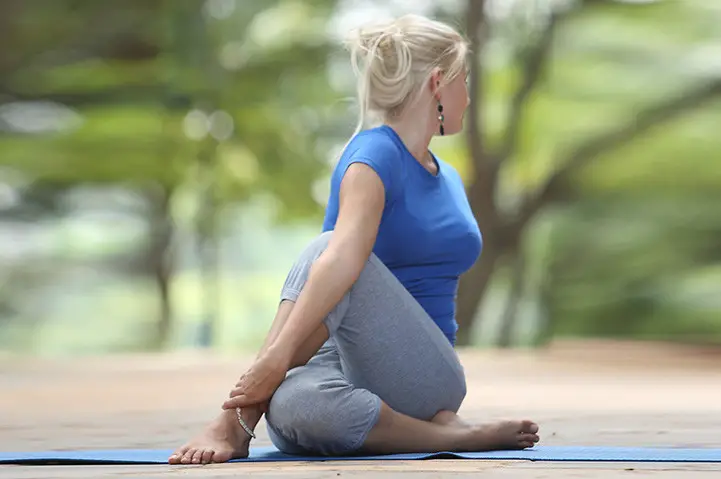
Ardha Mastyendrasana Steps:
- Sit comfortably erect with your legs stretched out.
- Now, bend your left leg such that the heel of the left foot lies next to the right hip. You could also keep the left leg stretched out if you like.
- Then, place the right leg next to the left knee by taking it over the knee.
- Twist your torso, neck, and shoulders towards the right, and set your gaze over your right shoulder. Make sure your spine is comfortably erect.
- There are many ways you can place your arms to increase and decrease the stretch. But to do it simply, you can place the right hand behind you, and the left hand on the right knee.
- Hold the pose for a few seconds, about 30 to 60 as you breathe slowly, yet deeply.
- Exhale and release the right hand, and then the waist, chest, and finally the neck. Relax as you sit straight.
- Repeat the steps on the other side, and then exhale and come back to the front.
4. Uttanasana (Standing forward fold):
Practicing Uttanasana quiets a busy mind, and balances the nervous system spreading calm and peace.

Uttanasana Steps:
- Start with Mountain Pose relaxing, exhale, and bend the upper body forward from the hips, not the waist.
- Without straining the body continue to bend stretching your hips till your hands touch your feet.
- Place the palms by the side of your feet as much as possible and touch your forehead to your knees.
- Take deep and slow breaths and relax your body.
Precautions:
People with any spine injury, pain in ankles or hip joints, knee problems, sciatica, heart problems, severe back pain or an abdominal hernia should avoid this pose.
5. Adho Mukha Svanasana (Downward Facing Dog Pose):
This pose also calms the mind, lengthens the spine, and energizes the body. Hence the best yoga for depression.
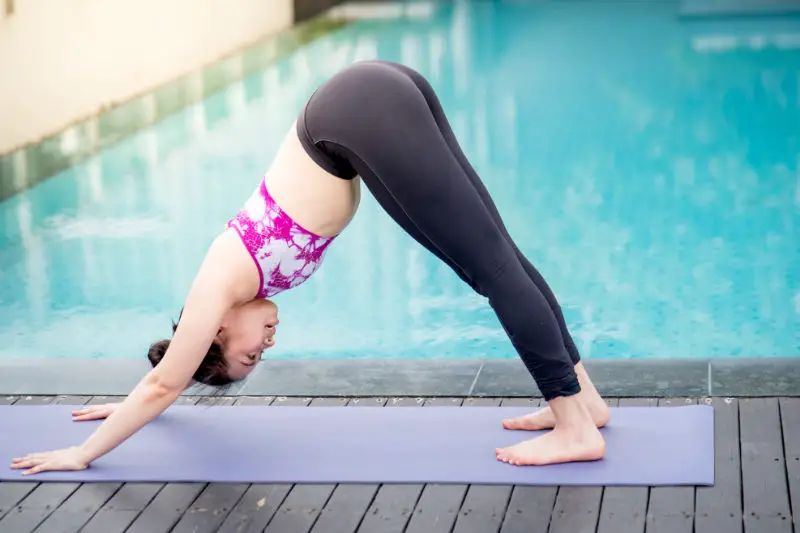
Adho Mukha Svanasana Steps:
- Stand on your four limbs like a table with palms placed shoulder-width apart and toes placed hip-width apart parallelly. Tuck your toes inward.
- Exhale; lift the knees off the floor, legs straight, and form an inverted V-shape pushing the body weight into the palms and hips up towards the ceiling.
- Attempt to touch your heels to the ground, while keeping your legs straight at the knees.
- Push away from the ground through your palms, keeping your shoulders square and your head between your arms. Keep neck neutral and body weight evenly distributed. Touch the ears to the inner arms and sink your hands into the ground.
- Stay in this position and take deep breaths.
Release the pose get back to the table pose bending your knees while exhaling.
Adhomukha Svanasana Benefits:
- This pose strengthens the back, neck, shoulders, and legs.
- It improves circulation and restores energy.
Balasana(Child Pose):
Balasana, the child pose, heals the body and mind. You can calm your mind and shift the focus to breathing. It relaxes the spine and hips and gently stretches the shoulder blades.
Balasana Steps:
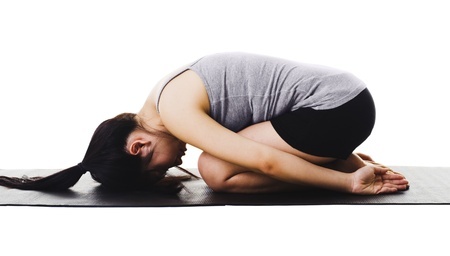
- Sit down on your knees and join the thighs, knees, and big toes with hips on the heels left distant comfortably.
- Place your palms on the floor and move your knees wide. (If your hips are not touching the heels place a bolster under the feet)
- Inhale; raise your arms stretching the spine.
- Exhale; bend your torso forward and rest it on the floor between the knees. Keep your palms one above the other and place them on the floor above your head stretching your hands full. (If you’re not comfortable resting on the floor place a bolster in between the knees)
- Breathe deeply for 1-2 minutes in this position. Make sure you’re not forcing the pose.
Release the pose with an inhalation raising the arms up and as you exhale lower the arms and release the pose.
Treatment:
Tricyclic antidepressants are the mainstay of treatment out of newer antidepressants, serotonin noradrenaline reuptake inhibitors (SNRIs), given their similarities to TCAs. To treat significant depression effectively, usually antidepressants are used at therapeutic doses for at least four weeks before increasing to higher doses or changing to another agent at doctor’s supervision.
Cognitive behavior therapy (CBT) or interpersonal therapy was found to be more effective than placebo or supportive therapy in treating major depression.
Successful treatment of major depression will reduce pain and improve function and quality of life for patients with chronic pain over time.
Yoga practice is known to improve a person’s physical and mental functioning. In psychiatry, yoga-based interventions have been successfully used both as a standalone and supportive treatment of disorders such as depression, anxiety, and insomnia.
Can you ever be cured of depression?
Yoga makes you stronger, more flexible, and more resilient. They also have the added benefit of releasing tension and emotion. When you practice, you raise serotonin, oxytocin, and GABA levels in your body. Feeling “happy” has everything to do with the chemical reactions in your body which help ease depression and anxiety.
While depression can be treated, and symptoms can be alleviated, depression cannot be “cured.” Instead, remission is the goal. There’s no universally accepted definition of remission, as it varies for each person. People may still have symptoms or impaired functioning with remission.
Yoga and Meditation won’t cure your depression, but they can be a big help. Shitali pranayama, which is a cooling form of pranayama, is great for calming the mind and body, resulting in lower hypertension and relaxation. And the corpse pose is one of the most popular yoga poses for relieving stress, and anxiety and reducing depression symptoms. Since Kapalbhati Pranayama calms your mind, it benefits you by helping with mood swings and minor anxiety.
